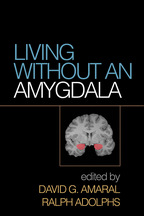Living without an Amygdala
Edited by David G. Amaral and Ralph Adolphs
Hardcovere-bookprint + e-book
Hardcover
orderJune 13, 2016
ISBN 9781462525942
Price: $96.00 430 Pages
Size: 6" x 9"
“A comprehensive and compelling overview of this small, but incredibly complex, brain region….Stylistically, the book shifts back and forth between prose-like storytelling and scientific journal articles. This style conveys and elucidates the existing literature, while also illustrating the real-world ramifications of navigating without the ability to fear….The book will be a worthwhile addition to the collections of graduate students and professionals. Highly recommended. Graduate students; researchers and faculty; professionals.”

—Choice Reviews
“Living Without an Amygdalais a very readable compendium of historical, scientific, and clinical information about the amygdaloid complex, the brain’s yellow/red, caution/stop signs. The title…compels even an experienced student of neuroscience to start reading, motivated by the possibility that he or she will discover something about his or her own problems with memory, decision making, and emotional intelligence….Living Without an Amygdaladocuments the wide-ranging emotional states and psychopathological conditions that are affected by the absence of amygdala….The editors and contributors to Living Without an Amygdalamake it abundantly clear that amygdala is much more than the yellow/red, caution/danger flags and signposts on the brain’s information-processing superhighway and provide the reader with indispensable background for creating novel hypotheses and planning future research about how our brains construct emotional experiences.”

—PsycCRITIQUES
“An excellent book from two of the major students of the amygdala. This volume reviews, outlines, and organizes knowledge about the amygdala—the orchestrator of emotion—in a wonderfully clear and systematic fashion that brings our understanding from its solid foundation in rodents to a new level. This is a 'must read' for anyone interested in emotion and its psychological and biological consequences.”

—Eric Kandel, MD, Director, Kavli Institute for Brain Science; Co-Director, Mortimer B. Zuckerman Mind Brain Behavior Institute, Columbia University
“Over the past several decades much has been learned about the role of the amygdala in behavior, mostly from studies of nonhuman animals. This volume makes a useful contribution by bringing together the current state of knowledge about the human amygdala.”

—Joseph E. LeDoux, PhD, Center for Neural Science and Department of Psychology, New York University
“Living without an Amygdala provides an important corrective to the popular belief that the primary function of the amygdala is to create a state of fear. The elegant research in this volume affirms the adage that ugly facts often destroy beautiful ideas, and provides neuroscientists and psychologists with a richer understanding of the amygdala.”

—Jerome Kagan, PhD, Department of Psychology (Emeritus), Harvard University
“This book offers a novel window into the function of the amygdala across development by interweaving controlled primate studies of amygdala lesions with detailed histories of humans who have bilateral amygdala damage. The marriage of experimental neuroscience with personal and empathic narratives results in an informative, compelling work. This book will surely become a classic for students, instructors, and researchers who study the amygdala, human fear and anxiety, and the etiology of mental disorders. It should be of much interest in courses on affective and cognitive neuroscience, as well as abnormal psychology, psychiatry, and developmental psychopathology.”

—Katie McLaughlin, PhD, Department of Psychology, University of Washington
—Choice Reviews
“Living Without an Amygdalais a very readable compendium of historical, scientific, and clinical information about the amygdaloid complex, the brain’s yellow/red, caution/stop signs. The title…compels even an experienced student of neuroscience to start reading, motivated by the possibility that he or she will discover something about his or her own problems with memory, decision making, and emotional intelligence….Living Without an Amygdaladocuments the wide-ranging emotional states and psychopathological conditions that are affected by the absence of amygdala….The editors and contributors to Living Without an Amygdalamake it abundantly clear that amygdala is much more than the yellow/red, caution/danger flags and signposts on the brain’s information-processing superhighway and provide the reader with indispensable background for creating novel hypotheses and planning future research about how our brains construct emotional experiences.”
—PsycCRITIQUES
“An excellent book from two of the major students of the amygdala. This volume reviews, outlines, and organizes knowledge about the amygdala—the orchestrator of emotion—in a wonderfully clear and systematic fashion that brings our understanding from its solid foundation in rodents to a new level. This is a 'must read' for anyone interested in emotion and its psychological and biological consequences.”
—Eric Kandel, MD, Director, Kavli Institute for Brain Science; Co-Director, Mortimer B. Zuckerman Mind Brain Behavior Institute, Columbia University
“Over the past several decades much has been learned about the role of the amygdala in behavior, mostly from studies of nonhuman animals. This volume makes a useful contribution by bringing together the current state of knowledge about the human amygdala.”
—Joseph E. LeDoux, PhD, Center for Neural Science and Department of Psychology, New York University
“Living without an Amygdala provides an important corrective to the popular belief that the primary function of the amygdala is to create a state of fear. The elegant research in this volume affirms the adage that ugly facts often destroy beautiful ideas, and provides neuroscientists and psychologists with a richer understanding of the amygdala.”
—Jerome Kagan, PhD, Department of Psychology (Emeritus), Harvard University
“This book offers a novel window into the function of the amygdala across development by interweaving controlled primate studies of amygdala lesions with detailed histories of humans who have bilateral amygdala damage. The marriage of experimental neuroscience with personal and empathic narratives results in an informative, compelling work. This book will surely become a classic for students, instructors, and researchers who study the amygdala, human fear and anxiety, and the etiology of mental disorders. It should be of much interest in courses on affective and cognitive neuroscience, as well as abnormal psychology, psychiatry, and developmental psychopathology.”
—Katie McLaughlin, PhD, Department of Psychology, University of Washington



